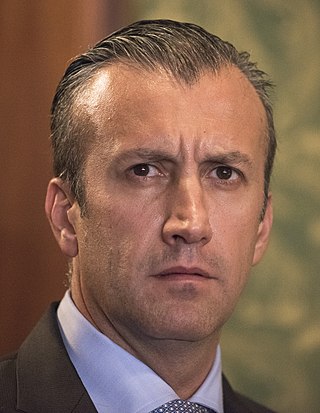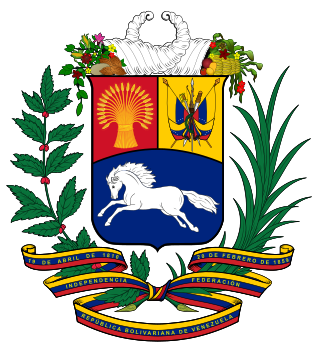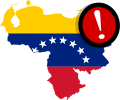
The Supreme Justice Tribunal is the highest court of law in the Bolivarian Republic of Venezuela and is the head of the judicial branch. As the independence of the Venezuelan judiciary under the regime of Nicolás Maduro is questioned, there have recently been many disputes as to whether this court is legitimate.
José Vicente Rangel Ávalos is a Venezuelan politician and mayor of Sucre Municipality in Caracas. He is the son of Venezuelan former vice president José Vicente Rangel Vale and Chilean sculptor Ana Avalos.

Censorship in Venezuela refers to all actions which can be considered as suppression in speech in the country. More recently, Reporters Without Borders ranked Venezuela 159th out of 180 countries in its World Press Freedom Index 2023 and classified Venezuela's freedom of information in the "very difficult situation" level.

Tareck Zaidan El Aissami Maddah is a Venezuelan politician, who served as the vice president of Venezuela from 2017 to 2018. He served as Minister of Industries and National Production since 14 June 2018, and as Minister of Petroleum from 27 April 2020 until 20 March 2023. He previously was Minister of the Interior and Justice from 2008 to 2012, Governor of Aragua from 2012 to 2017, and the vice president of Venezuela from 2017 to 2018. While holding that office, El Aissami faced allegations of participating in corruption, money laundering and drug trafficking. In 2019, U.S. Immigration and Customs Enforcement (ICE) added El Aissami to the ICE Most Wanted List, listed by the Homeland Security Investigations unit. El Aissami, who was among the power brokers in Nicolás Maduro's government, resigned on 20 March 2023 during a corruption probe. He was arrested by the Venezuelan prosecutor's office on charges of treason, money laundering and criminal association.

Colectivos are far-left Venezuelan armed paramilitary groups that support the Bolivarian government, the Great Patriotic Pole (GPP) political alliance and Venezuela's ruling party, and the United Socialist Party of Venezuela (PSUV). Colectivo has become an umbrella term for irregular armed groups that operate in poverty-stricken areas.

The 2014 Venezuelan protests began in February 2014 when hundreds of thousands of Venezuelans protested due to high levels of criminal violence, inflation, and chronic scarcity of basic goods because of policies created the Venezuelan government. The protests have lasted for several months and events are listed below according to the month they had happened.

Delcy Eloína Rodríguez Gómez is a Venezuelan lawyer, diplomat, and politician serving as the vice president of Venezuela since 2018. Gómez has held several positions during the presidencies of Hugo Chavez and Nicolas Maduro. She was also Minister of Popular Power for Communication and Information of Venezuela from 2013 to 2014, Minister of Foreign Affairs from 2014 to 2017 and President of the Constituent Assembly of Venezuela from 4 August 2017 to 14 June 2018 until her retirement from office on June 15, 2018 to assume the vice presidency of the country. She currently holds the positions of Minister of Economy, Finance, and Foreign Trade, and Executive Vice President of Venezuela. She is a member of the national leadership of the United Socialist Party of Venezuela. The European Union, the United States and Canada have placed sanctions on her for human rights violations and the political crisis in the country.

The 2017 Venezuelan protests began in late January following the abandonment of Vatican-backed dialogue between the Bolivarian government and the opposition. The series of protests originally began in February 2014 when hundreds of thousands of Venezuelans protested due to high levels of criminal violence, inflation, and chronic scarcity of basic goods because of policies created by the Venezuelan government though the size of protests had decreased since 2014. Following the 2017 Venezuelan constitutional crisis, protests began to increase greatly throughout Venezuela.

On 29 March 2017, the Supreme Tribunal of Justice (TSJ) of Venezuela took over legislative powers of the National Assembly. The Tribunal, mainly supporters of President Nicolás Maduro, also restricted the immunity granted to the Assembly's members, who mostly belonged to the opposition.

The Mother of All Marches, also known as the Mother of All Protests, was a day of protests held on April 19, 2017, in Venezuela against the Chavista government of president Nicolás Maduro. The protests began after the Supreme Tribunal of Justice dissolved the National Assembly and took over its legislative powers March 29, 2017 in what was called a self-coup. The dissolution of the National Assembly was reversed shortly thereafter on April 1, 2017.

The 2017 Venezuelan protests were a series of protests occurring throughout Venezuela. Protests began in January 2017 after the arrest of multiple opposition leaders and the cancellation of dialogue between the opposition and Nicolás Maduro's government.

Constituent Assembly elections were held in Venezuela on 30 July 2017 to elect the members of the 2017 Constituent National Assembly. Unlike the 1999 Constituent National Assembly, which was assembled following a referendum, the 2017 election was convened by the presidential decree of President Nicolás Maduro. Smartmatic, the Venezuelan-owned company which provided the voting machines, stated that the results were tampered with by the CNE, and that the turnout was off by at least one million votes.

On 5 July 2017, colectivos and supporters of President Nicolás Maduro stormed the Palacio Federal Legislativo on the Independence Day of Venezuela, assaulting many members of the opposition-led National Assembly. At least 12 opposition legislators and their staff were injured as a result of the attack.

A referendum was held in Venezuela on 16 July 2017. The referendum was called by the National Assembly in response to the constitutional crisis and President Nicolás Maduro's plans for a Constituent Assembly. The referendum was an act of civil disobedience in the context of the application of Articles 333 and 350 of the Venezuelan constitution, with the articles calling for Venezuelans to "disown any regime ... that violates democratic values", especially since the National Electoral Council and the Supreme Tribunal of Justice were not recognized in the referendum. The opposition Democratic Unity Roundtable (MUD) announced that there would be 2,030 areas for the popular consultation nationwide to serve more than 19 million voters.

2018 protests in Venezuela began in the first days of January as a result of high levels of hunger by desperate Venezuelans. Within the first two weeks of the year, hundreds of protests and looting incidents occurred throughout the country. By late-February, protests against the Venezuelan presidential elections occurred after several opposition leaders were banned from participating. Into March, the Maduro government began to crack down on military dissent, arresting dozens of high-ranking officials including former SEBIN director Miguel Rodríguez Torres.

Óscar Alberto Pérez was a Venezuelan rebel leader and an investigator for the CICPC, Venezuela's investigative agency. He was also an actor in a film to promote the role of detectives in the CICPC. He is better known for being responsible for the Caracas helicopter incident during the 2017 Venezuelan protests and the 2017 Venezuelan constitutional crisis. His killing in the El Junquito raid received worldwide attention by the media and the political establishment, and was met with accusations of extrajudicial killing.

The El Junquito raid was a police and military raid that occurred on 15 January 2018 in El Junquito, Capital District, Venezuela, which resulted in the death of rebel Óscar Alberto Pérez and members of his movement.
The Supreme Tribunal of Justice of Venezuela (TSJ) in exile is an institution that some, including the Organization of American States, consider to be the legitimate highest court of law in Venezuela and the head of the judicial branch, as opposed to the Supreme Tribunal of Justice. It was established on 21 July 2017 following the 2017 Venezuelan constitutional crisis. The TSJ's 33 members have been based in Chile, Colombia, Panama, and the United States due to the political crisis in Venezuela.

On 4 August 2018, two drones detonated explosives near Avenida Bolívar, Caracas, where Nicolás Maduro, the President of Venezuela, was addressing the Bolivarian National Guard in front of the Centro Simón Bolívar Towers and Palacio de Justicia de Caracas. The Venezuelan government claims the event was a targeted attempt to assassinate Maduro, though the cause and intention of the explosions is debated. Others have suggested the incident was a false flag operation designed by the government to justify repression of opposition in Venezuela.
Bladimir Humberto Lugo Armas is a brigadier general of the Venezuelan National Guard. By 2017, he was the commander of the unit of this force that guarded the Federal Legislative Palace, the government buildings of Venezuela.

















